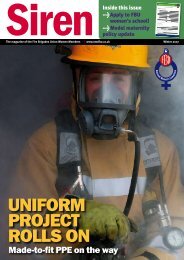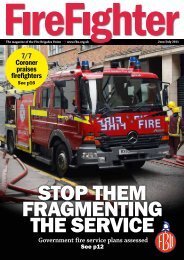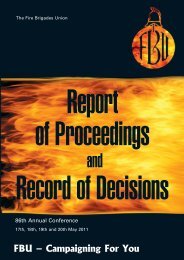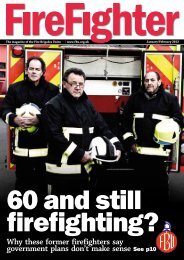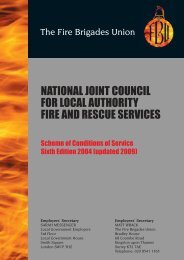Report - Fire Brigades Union
Report - Fire Brigades Union
Report - Fire Brigades Union
Create successful ePaper yourself
Turn your PDF publications into a flip-book with our unique Google optimized e-Paper software.
SECTION B — FIRE AND RESCUE SERVICE POLICY<br />
efficient service which directly addresses local needs. It calls<br />
for greater choice in the nature of provision, including<br />
employee mutuals, and the ability of communities to consider<br />
fire amongst the other priorities they have in determining<br />
resources. Underpinning this, we need a new and in some ways<br />
more professional approach from the service in dealing with the<br />
built environment, reducing risk, fires, and property loss.<br />
To support increased localism, there will need to be<br />
assurances regarding interoperability, a collective and<br />
responsive understanding of national threat and risk, and<br />
transparent standards. Until the sector is fully mature enough<br />
to take responsibility for these aspects itself, there will be a<br />
need for continuing central government involvement in these<br />
areas. These issues need to be addressed in the global context<br />
of the decentralisation agenda.<br />
The fire and rescue service faces many challenges. It consists<br />
of many highly dedicated and professional people working hard<br />
to protect the communities they serve. But much more needs<br />
to be done to ensure that the service can adapt to a rapidly<br />
changing society, and a demanding financial climate. The hard<br />
work provided by the workstream leads gives you a road map<br />
for the future, and I commend their reports to you.<br />
Finally, at a meeting held on 8th December involving the wider<br />
industry to discuss issues arising from <strong>Fire</strong> Futures, those<br />
attending agreed to proceed with a number of commitments at<br />
no cost to the Government. At their request, I have added their<br />
commitment at Section 9 of this report. Notably, the wider<br />
industry has committed to resource and publish guidance on<br />
the built environment; to disseminate knowledge through<br />
structured learning programmes; to lead an independent<br />
research panel with sector organisations voluntary contributing<br />
with expertise; and to provide a <strong>Fire</strong> Knowledge website with<br />
free access to available data.<br />
Brian Robinson<br />
10 December 2010<br />
1. INTRODUCTION<br />
Current Situation<br />
The fire sector, or more precisely ‘<strong>Fire</strong> UK’, encompasses a<br />
vast array of talent and vocations across the breadth of the<br />
public and private sectors. It must be taken to include a<br />
variety of participants including the fire safety industry,<br />
building control bodies, government departments, design<br />
specialists, architects, professional bodies, insurance, BSI<br />
standards, testing and research organisations.<br />
This diversity represents a great strength. The fire sector<br />
as a whole has made great strides in recent times to<br />
prevent fire deaths which have continued to a fall since<br />
1981/82. At a ratio of about 8 deaths in building fires per<br />
year per million of population performance can be said to<br />
be amongst the best in Europe (where the number lies<br />
generally in the range 4 to 20 per million inhabitants)1.<br />
<strong>Fire</strong> safety in the UK can point to a relatively good record of<br />
improvement over the last twenty years in particular. This<br />
has been achieved, in the main, by a progressive and<br />
accumulative process of evolutionary development, partly<br />
in response to significant events and partly in tune with<br />
developing fire safety concepts.<br />
However, there are signals from a variety of sources that,<br />
when taken together, caution against complacency. A good<br />
fire safety performance in the past is no guarantee for<br />
continuing that performance into the future.<br />
a) The five years from 2003 to 2007 show more<br />
firefighter deaths than for any previous consecutive 5<br />
year period since the 1970’s (even excluding four<br />
deaths in the Atherstone fire).<br />
b) The numbers of large loss fires reported by the <strong>Fire</strong><br />
Protection Association (FPA) are increasing and the<br />
Association of British Insurers (ABI) quote insured<br />
losses in 2009 of £1.3 billion, increasing at 16% on the<br />
previous year on a rising trend. Figures for uninsured<br />
losses are variously estimated to be several times the<br />
insured loss.<br />
c) Rising levels of arson continue to cause concern, not<br />
only in domestic situations but also affecting public<br />
buildings such as schools and care homes.<br />
d) The ABI reference research by AXA Insurance which<br />
suggests that 80% of businesses that suffer a major<br />
catastrophe fail within 18 months, 69% of SMEs have<br />
no contingency plan to cope with serious incidents that<br />
could affect their business, and 41% have no business<br />
interruption or loss of earning insurance. The ABI also<br />
notes that approximately 50% of national income and<br />
employment comes from SMEs.<br />
e) Regular reports from the fire safety industry provide a<br />
disturbing picture of an increasing tendency at large to<br />
think that fire safety can be relegated to a lower order<br />
of priority, even substantially dispensed with as<br />
specifications are modified and pared down in a search<br />
for the minimum rather than the optimum.<br />
There is also significant evidence of deterioration of the<br />
inbuilt fire protection in buildings, coupled to a lack of<br />
effective enforcement arrangements. There is also<br />
indication of a fundamental inability to co-operate across<br />
the sector and indeed argument has been raised in <strong>Fire</strong><br />
Futures reports that the current fire and rescue service<br />
cannot operate as a joined up service.<br />
Key concerns are:<br />
● There are differences in training, assessment and<br />
operational capability.<br />
●<br />
●<br />
●<br />
●<br />
Operational doctrine has not been updated, and it has<br />
been left with central government to take this forward.<br />
Interoperability and risk protocols applying to national,<br />
local and generic risk have no common understanding.<br />
The linkages between national threat and FRS risk<br />
planning are neither clear nor consistent.<br />
The existing arrangements do not provide the coherence<br />
and authority to co-ordinate national functions effectively.<br />
54 FBU Annual <strong>Report</strong> 2011





